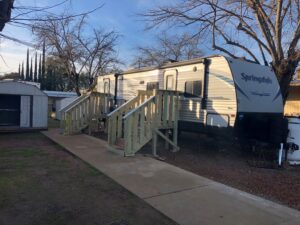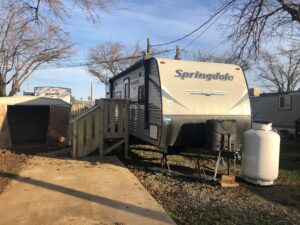In the weeks following the devastating wildfires that swept through California in 2020, FEMA approved a Direct Housing Program for eligible survivors in Butte County (DR-4558). Since then, California Governor’s Office of Emergency Services (Cal OES) Individual Assistance has been working closely with FEMA Individual Assistance to address the housing needs of those survivors whose homes had been destroyed.
Due to this partnership, as of January 11, 2021 the first group of eight households who lost their homes in the North Complex Fire have been licensed into a FEMA Direct Housing site located in Oroville. Meanwhile, Cal OES and FEMA are continuing to work together to place the remaining wildfire survivors who have applied for disaster assistance. These individuals are encouraged to keep in touch with FEMA to update their case information.

FEMA Direct Housing Trailer in Butte

FEMA Direct Housing Trailer in Butte
Although the deadline for survivors of DR-4558 to apply for FEMA assistance has passed, individuals who have received a FEMA denial letter can update their application using the original method used to register with FEMA: online at DisasterAssistance.gov; with the FEMA app you downloaded to your smartphone or tablet; or by calling the FEMA Helpline at 800-621-3362 (TTY 800-462-7585) between 7 a.m. and 10:30 p.m. PDT. If you use a relay service such as a videophone, Innocaption or CapTel, provide FEMA the specific number assigned to that service when you register
For those who are interested in learning more about the recovery process after a wildfire, please visit: https://wildfirerecovery.caloes.ca.gov/
About the Direct Housing Program
The Direct Housing Program provides temporary housing in the form of recreational vehicles (RVs), Manufactured Housing Units (MHUs) and Multi-family Lease and Repair and Direct Lease.
Eligibility for direct housing is based on the extent of damage to the survivor’s house, whether insurance to cover damages is available and other factors.
Installing each unit involves a site inspection, local permits as well as utility hookups. Since installations, like other construction projects, are subject to delays due to weather problems and coordination issues, the process can take time.

